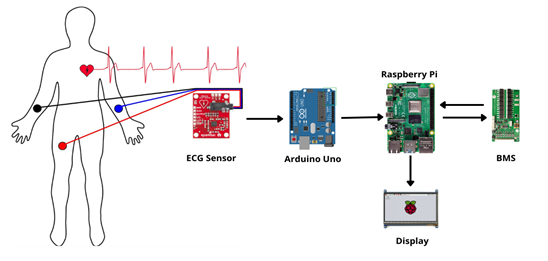Portable ECG Device Based on Deep learning and Raspberry PI 4
DOI:
https://doi.org/10.58564/IJSER.3.2.2024.181Keywords:
Heart Disease, ECG, Deep Learning, VGG, Raspberry pi4Abstract
Positive characteristics physicians utilize electrocardiograms (ECGs) for the interpretation and diagnosis of cardiac conditions. Hence, it is imperative to automate the analyses of ECG heartbeats in order to diagnose cardiac diseases with optimal effectiveness. The rural in Iraq are deficient in essential equipment and require state-of-the- art medical technologies be low cost, easy to use and read, in addition to the students and researchers in the field of medicine and medical engineering who are interested to developing new technologies to monitor cardiac conditions. This research paper focuses on designing and implementing a technique for forecasting arrhythmia, while simultaneously monitoring the ECG signals, hence developing an arrhythmia predication model, based on Raspberry pi4, real-time ECG tracking system using the VVG-16 algorithm, NNC. The use of deep learning model and algorithms has an impressive overall accuracy of 97.1% in predicting arrhythmia and 98.4% in overall system accuracy. The machine is being developed using AD8232, Arduino UNO, Raspberry pi4, biomedical sensor pad and battery, this method can be viewed as a practical application of the Internet of Things (IOT) idea that describes the procedure for determining the number of heartbeats from the ECG signal and display the diseases type on the same screen from mobile application or computer.
References
R. R. van de Leur et al., “Automatic triage of 12-lead ecgs using deep convolutional neural networks,” J. Am. Heart Assoc., vol. 9, no. 10, 2020, doi: 10.1161/JAHA.119.015138.
P. Singh and A. Sharma, “Interpretation and Classification of Arrhythmia Using Deep Convolutional Network,” IEEE Trans. Instrum. Meas., vol. 71, pp. 1–12, 2022, doi: 10.1109/TIM.2022.3204316.
V. Sharmila, “Multi-Class Arrhythmia Detection using a Hybrid Spatial-Temporal Feature Extraction Method and Stacked Auto Encoder,” Int. J. Intell. Eng. Syst., vol. 14, no. 2, pp. 82–94, 2021, doi: 10.22266/ijies2021.0430.08.
D. N. V. S. L. S. Indira et al., “Detection of Cardiac Arrhythmia Using Multi-Perspective Convolutional Neutral Network for ECG Heartbeat Classification,” Rev. d’Intelligence Artif., vol. 36, no. 4, pp. 629–634, 2022, doi: 10.18280/ria.360416.
I. Afzal et al., “Noisy ECG signal data transformation to augment classification accuracy,” Comput. Mater. Contin., vol. 71, no. 2, pp. 2191–2207, 2022, doi: 10.32604/cmc.2022.022711.
S. K. Saini and R. Gupta, “Artificial intelligence methods for analysis of electrocardiogram signals for cardiac abnormalities: state-of-the-art and future challenges,” Artif. Intell. Rev., vol. 55, no. 2, pp. 1519–1565, Feb. 2022, doi: 10.1007/s10462-021-09999-7.
F. Khodadadi, A. V. Dastjerdi, and R. Buyya, “Internet of Things: an overview,” in Internet of Things, Elsevier, 2016, pp. 3–27. doi: 10.1016/B978-0-12-805395-9.00001-0.
X. He, H. Yin, Z. Dong, and Y. Fu, “A framework for developing cyber physical systems,” Proc. Int. Conf. Softw. Eng. Knowl. Eng. SEKE, no. 3, pp. 236–241, 2017, doi: 10.18293/SEKE2017-095.
F. Al-Turjman and S. Alturjman, “Context-Sensitive Access in Industrial Internet of Things (IIoT) Healthcare Applications,” IEEE Trans. Ind. Informatics, vol. 14, no. 6, pp. 2736–2744, Jun. 2018, doi: 10.1109/TII.2018.2808190.
B. Bhandari, “A Hybrid IIoT-based System for Real-time Monitoring and Control of Industrial Processes,” J. Algebr. Stat., vol. 11, no. 1, pp. 82–93, 2020, doi: 10.52783/jas.v11i1.1434.
G. Xu, “IoT-Assisted ECG Monitoring Framework with Secure Data Transmission for Health Care Applications,” IEEE Access, vol. 8, pp. 74586–74594, 2020, doi: 10.1109/ACCESS.2020.2988059.
P. Kamble and A. Birajdar, “IoT Based Portable ECG Monitoring Device for Smart Healthcare,” 5th Int. Conf. Sci. Technol. Eng. Math. ICONSTEM 2019, pp. 471–474, 2019, doi: 10.1109/ICONSTEM.2019.8918776.
B. A. Teplitzky, M. McRoberts, and H. Ghanbari, “Deep learning for comprehensive ECG annotation,” Hear. Rhythm, vol. 17, no. 5, pp. 881–888, 2020, doi: 10.1016/j.hrthm.2020.02.015.
J. Chen, K. Liao, K. Wei, H. Ying, D. Z. Chen, and J. Wu, “ME-GAN: Learning Panoptic Electrocardio Representations for Multi-view ECG Synthesis Conditioned on Heart Diseases,” Proc. Mach. Learn. Res., vol. 162, pp. 3360–3370, 2022.
Q. Geng et al., “An ECG Classification Method Based on Multi-Task Learning and CoT Attention Mechanism,” Healthc., vol. 11, no. 7, pp. 1–13, 2023, doi: 10.3390/healthcare11071000.
B. Venkataramanaiah, M. Anuradha, K. Balasubramanian, C. Gnanaprakasam, D. P. Kumar, and R. Palanikumar, “Cardiovascular Abnormalities Classification Model Using Machine Learning and Signal Processing Techniques,” Int. J. Intell. Syst. Appl. Eng., vol. 12, no. 6s, pp. 10–20, 2024.
D. O. Oyewola, E. G. Dada, and S. Misra, “Diagnosis of Cardiovascular Diseases by Ensemble Optimization Deep Learning Techniques,” Int. J. Healthc. Inf. Syst. Informatics, vol. 19, no. 1, pp. 1–21, 2023, doi: 10.4018/IJHISI.334021.
M.-S. Song and S.-B. Lee, “Comparative study of time-frequency transformation methods for ECG signal classification,” Front. Signal Process., vol. 4, no. January, pp. 1–12, 2024, doi: 10.3389/frsip.2024.1322334.

Downloads
Published
How to Cite
Issue
Section
License
Copyright (c) 2024 Ghassaq Saad Jameel, M. N. Al-Turfi , Wisam Salih Al-Obaidi, Ghzwan H. Hamoudi

This work is licensed under a Creative Commons Attribution-ShareAlike 4.0 International License.












